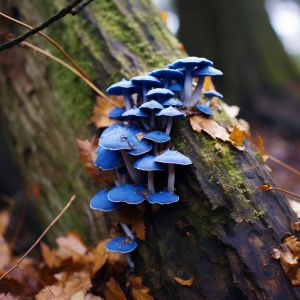Gravedigger Mushrooms: Difference between revisions
RaenAndaleio (talk | contribs) (Created page with "Gravedigger mushrooms (Mycelium sepulturum), also known as tombstone jewels, are a unique and elusive species of fungi native to the British Isles. These mystical mushrooms are renowned not only for their striking blue colour, but also for their significant role in the magical botanical world. === Appearance and Habitat === Gravedigger Mushrooms are characterized by their small, somber appearance, often found in clusters that seem to thrive on decay, primarily growing o...") |
RaenAndaleio (talk | contribs) No edit summary |
||
| (3 intermediate revisions by the same user not shown) | |||
| Line 1: | Line 1: | ||
Gravedigger mushrooms (Mycelium sepulturum), also known as tombstone jewels, are a unique and elusive species of fungi native to the British Isles. | [[File:Gravedigger mushrooms.jpg|thumb|Batch of gravedigger mushrooms on an old tree trunk]] | ||
Gravedigger mushrooms (''Mycelium sepulturum''), also known as tombstone jewels, are a unique and elusive species of fungi native to the British Isles. Despite their name, these mushrooms are not somber in appearance; instead, they are recognized for their striking blue colour and unique affinity for magical energies, particularly those emanating from ley lines. | |||
== Appearance and Habitat == | |||
Gravedigger | Gravedigger mushrooms are characterized by their small, somber appearance, often found in clusters that seem to thrive on decay, primarily growing on and under dead wood within dense forests. A distinctive feature of these mushrooms is their predilection for areas suffused with magical energies, particularly those near ley lines. This rare habitat requirement contributes to their scarcity and mystical properties. | ||
Historically, these mushrooms were frequently found in graveyards, leading to their ominous moniker. This association stems from an ancient practice where churches, often erected over significant cultural sites aligned with ley lines, inadvertently became fertile grounds for these fungi. This confluence of death, magic, and sacred geometry created the perfect conditions for | Historically, these mushrooms were frequently found in graveyards, leading to their ominous moniker. This association stems from an ancient practice where churches, often erected over significant cultural sites aligned with ley lines, inadvertently became fertile grounds for these fungi. This confluence of death, magic, and sacred geometry created the perfect conditions for gravedigger mushrooms to flourish. | ||
== Cultivation and Care == | |||
While Gravedigger Mushrooms are sought after for both magical and decorative purposes, cultivating them is a challenging endeavor. Their growth is intrinsically tied to the presence of magical energies, necessitating proximity to ley lines or other sources of magic for successful cultivation. This requirement makes them a rare and prized addition to magical gardens. Some enthusiasts attempt to grow them decoratively, but these efforts require innovative solutions to simulate the necessary magical environment. | |||
== Uses in Magic == | |||
Gravedigger Mushrooms | In the realm of magic, Gravedigger Mushrooms are esteemed for their ability to store magical energy, making them a valuable component in potions aimed at amplifying or replenishing magical reserves. Additionally, their inherent calming properties make them beneficial in stabilizing and harmonizing magical energies. While they are inedible, they pose no poison risk, allowing them to be safely used in a variety of magical and decorative applications without the risk of toxic exposure. | ||
Latest revision as of 21:26, 8 March 2024
Gravedigger mushrooms (Mycelium sepulturum), also known as tombstone jewels, are a unique and elusive species of fungi native to the British Isles. Despite their name, these mushrooms are not somber in appearance; instead, they are recognized for their striking blue colour and unique affinity for magical energies, particularly those emanating from ley lines.
Appearance and Habitat
Gravedigger mushrooms are characterized by their small, somber appearance, often found in clusters that seem to thrive on decay, primarily growing on and under dead wood within dense forests. A distinctive feature of these mushrooms is their predilection for areas suffused with magical energies, particularly those near ley lines. This rare habitat requirement contributes to their scarcity and mystical properties.
Historically, these mushrooms were frequently found in graveyards, leading to their ominous moniker. This association stems from an ancient practice where churches, often erected over significant cultural sites aligned with ley lines, inadvertently became fertile grounds for these fungi. This confluence of death, magic, and sacred geometry created the perfect conditions for gravedigger mushrooms to flourish.
Cultivation and Care
While Gravedigger Mushrooms are sought after for both magical and decorative purposes, cultivating them is a challenging endeavor. Their growth is intrinsically tied to the presence of magical energies, necessitating proximity to ley lines or other sources of magic for successful cultivation. This requirement makes them a rare and prized addition to magical gardens. Some enthusiasts attempt to grow them decoratively, but these efforts require innovative solutions to simulate the necessary magical environment.
Uses in Magic
In the realm of magic, Gravedigger Mushrooms are esteemed for their ability to store magical energy, making them a valuable component in potions aimed at amplifying or replenishing magical reserves. Additionally, their inherent calming properties make them beneficial in stabilizing and harmonizing magical energies. While they are inedible, they pose no poison risk, allowing them to be safely used in a variety of magical and decorative applications without the risk of toxic exposure.

